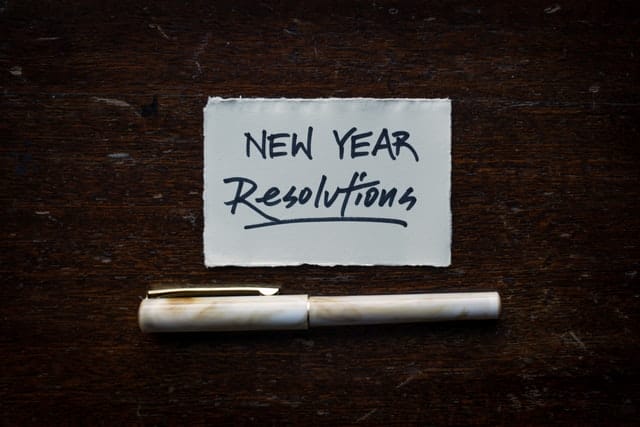You have been thinking about these changes year after year with countless new year’s resolutions, but life gets in the way, and old habits die hard. When life is busy and plans change, be it expectedly or not, we return to the behaviors we know; that familiarity brings comfort. What if I told you there was a way to make your New Year’s resolution stick this time? Read our article and learn why new year’s resolutions are good!
Every year in the past, Brad found himself sitting at the holiday dinner, dreading his turn to answer: what is his new year’s resolution? He does a quick self-evaluation to find what ingrained part of himself he will try to change this time around. “Go to the gym every day,” he says, as he quickly fills with self-doubt about how he will make that happen while also running errands, cooking meals, spending time with loved ones, and preparing for work.
Sometimes it feels like a new year’s resolution can be another way of saying, “How will I let myself down this year?” It was not until this year that I put my foot down and said “No” to the New Year’s resolutions that we know and love. Let me tell you why.

Discover Happy Habits says that millions of people set a new resolution for themselves each year, and 100 percent of those individuals start strong. However, what begins to happen by the end of week two is that number drops by 30 percent. By one month, the number lowers to a 64 percent success rate; by the six-month mark, more than half of the Americans who made a New Year’s Resolution have given up their efforts (2021). So, what’s the deal?
Table of Contents
The reality of new year’s resolutions
To illustrate this, let us look at Stephanie. Stephanie is a 32-year-old mom of two who also works as an accountant in the city. She decided she would start meditating three times a day in the new year. Stephanie has never meditated before except for the occasional guided session with her psychotherapist, but how hard could it be to sit still for ten minutes? She has an alarm on her phone to ring at three different points throughout the day, reminding her it is time for her new daily ritual. Week one of her resolution has gone exceptionally well! Stephanie sat for every meditation session and felt on top of the world. She is now the woman who meditates three times a day, someone she has always aspired to be.
Then life happens…
The second week rolls around, and she receives a call from her children’s school nurse; her youngest is sick with a stomach bug. She decides to forfeit her Monday afternoon meditation to pick up her son and care for him from home; it’s just one meditation, she has been “good” the week before, and Stephanie will make it up tomorrow. Well, surprise! Tomorrow comes, and Stephanie is backed up at work from spending yesterday using PTO to care for her son. She misses a second afternoon meditation and promises herself she will make it up on Wednesday. Stress begins to emerge when Stephanie wonders how she will fit five meditations in one day, seemingly creating the opposite of what her resolution is supposed to achieve. Stephanie gets all five meditations done on Wednesday and she is back on track, only skipping one lunch to get it done.
A few days later, Stephanie realizes she is sick with the same stomach bug her youngest had the week before, and now she is bedridden, too sick for anything besides ‘Friends’ reruns. Surely no one would expect Stephanie to sit up and meditate three times that day, but Stephanie is a perfectionist who identifies with consistency. She instantly fills with shame about why she cannot seem to get it together. “It is only ten minutes, three times a day!” she scolds herself. The pattern continues for weeks as life begins to get in the way, and Stephanie finds herself meditating once a week, which is more than many can say. However, once a week is not up to par with the new year’s resolution Stephanie set for herself back in December. Therefore, she spends each day ruminating on the fact that she cannot keep a promise to herself and is stuck in her old ways for as long as she lives.

Do you know this person?
Does any of this sound familiar? Take meditation and substitute it for whatever new year’s resolution you’ve wanted to do. Do other things get in the way? What if you fall behind? Would you bargain with yourself and promise you’ll make it up to yourself just to feel let down and disappointed later? The problem isn’t you! No, you’re not broken. It’s the way you are approaching reaching your goals. Once you shift your approach, you’ll see you can attain any goal you set for yourself much better than before.
The Issue with a New Year’s Resolution
The problem with a New Year’s Resolution is not the person setting it, their laziness, or their inability to stick to a goal. The problem is the goal itself. For example, if someone were to ask Brad if he has ever gone to the gym more than three days a week, let alone “every day”, he would give them a hard “Nope!” Yet, he expects himself to jump into the habit on Monday. The audacity! This example highlights the deep-rooted nature of our behavioral patterns, and the high expectations we set for ourselves to undo those roots immediately come January 1st.
Earlier I mentioned the ingrained part of the self we tend to focus on for a change, and that is where we run into trouble. It is deeply embedded, firmly established, and challenging to change something so intrinsic to who we are, which means that changing an ingrained behavior or characteristic will take a lot of time, practice, and patience. This definition of an integral behavior does not mean that change is impossible, but expecting oneself to change completely a consistent part of their identity sets one up for disappointment. Let’s avoid unnecessary feelings of shame, not by preventing growth but by resetting our expectations for that growth.
Take baby steps towards your New Year’s Resolution goal
I have a question: when you were a baby, did you walk out of the hospital? Or were you held until you rolled over, then you crawled, and then you walked? Would you expect a baby to walk at 3-months if they decided it was something they “ought” to do? Of course not! In come baby steps toward achieving your goal are vital to ensure you stick to your New Year’s resolutions long-term. Clinical psychologist and author Dr. Nicole LePera, better known as the “Holistic Psychologist” on Instagram, discusses why our brains are not wired for a New Year’s Resolution. Her blog mentions the fright response our brain experiences when thrown into new environments or habits that we are not used to doing. The brain can feel unfamiliar with the process and subsequently causes resistance to change, better known as self-sabotage. Essentially, asking yourself to go full throttle with a habit you have never done consistently is overwhelming for your brain. The expectation to keep that resolution can cause feelings of shame and guilt when your brain returns to homeostasis, (as its naturally meant to do).
Welcome the challenge
Transformation is hard. Change is foreign, and it is scary. In fact, according to research by Cynthia Vinney in 2021, a common defense mechanism against the discomfort of change is regression. Regression, in psychology, is known as the act of returning to a former state of development in times of danger, stress, trauma, or discomfort. This concept primarily relates to individuals who revert to earlier developmental stages in their life to cope with difficult situations and emotions. Suppose we apply this phenomenon to our discussion of resolutions. In that case, you can see how the risk and discomfort of change may cause an individual to revert to past behaviors that are familiar. The familiarity feels safe, but just because something is comfortable does not mean it is in line with your goals. The regression is another way to explain how individuals may lose steam in their endeavor to change in the new year, especially when change can be synonymous with scary.
Change is Possible
Before you think you are stuck in your ways, let me tell you about the concept of neuroplasticity. Neuroplasticity is the brain’s ability to change or adapt throughout life through the production of neurons or information messengers. Until recently, research was unclear and thought neuroplasticity strictly occurred within the limits of early developmental stages; however, now research suggests that plasticity and brain adaptation may occur at various phases in our lifespan. This research indicates that in young, middle, and late adulthood, individuals could have the ability to adapt the way their brain is wired. The good news is that, if proven true, newly learned behaviors can become ingrained even after decades of old habits have taken place. So, resolutions, as we know them, are out the window. Hooray! But wait, you still want to better yourself. Of course, you do! Here are some ways to ensure you become a better you past January 31st.

-
Start realistic with your new year’s resolution.
- Consider whether the resolution you decide on is within your capabilities. What are your goals? Are they physically attainable? Are your goals accessible? Do you have time set aside to accomplish these goals? Are these goals within the limits of your livelihood? If yes, this is a great start!
- Consider what might get in the way of these goals despite having the capabilities on your own of reaching them. What else is in your future that might coincide with achieving these goals? For example, you’re family planning, and you’re the person who will be carrying the child. Your goal is to lose weight. Will having a child get in the way of that goal? What is in your present that will need work first? For example, you’re miserable at your job, and the job you think you could be happy in entails a significant pay cut. You’re the primary breadwinner of your family. What does this mean for your family?
-
Start with a small goal.
- Starting small is where the baby steps come in. Ask yourself if your resolution would be more appropriate to reach gradually. Creating a scale from the easiest to the most challenging form of your goal can help you ease into the habit. If your goal is to get to the gym 5x/week, but you haven’t been to the gym in months, and you membership is inactive, you’ll need to start small. Can you think of small, doable objectives that you can build on to get you to this main goal of getting to the gym? What would it feel like if you changed your commute route to pass by the gym each day? Can you lay out your workout outfit the night before? Is it more feasible at first to think about starting at home? Is there somewhere in your home you can set up a yoga mat? What do you think the next objective should be using these examples? As time goes on, you can evaluate your progress and adapt your goals accordingly. The best part about this tip is reviving your plans at each reassessment. Every one to two months, a new motivation can give you something to look forward to as you build your new habit.
- Additionally, the frequency of the behavior applies to this situation, but so does the amount of the resolution. If you decide this is the year you will run two miles a day, but you’re like Brad, and the most you have ever run was the one-mile-test in high school, you may find it valuable to start at a quarter- or half-mile goal for a few weeks before escalating to two miles a day.
-
Make sure they are measurable.
- The easiest way to build on your goals is to know whether you are meeting them. There is a difference between “I’m going to journal more” and “I’m going to journal for 30 minutes at least three times a week.” If you find that you can successfully do two entries per week but that third entry slips away, maybe adjust your new year’s resolution for two entries per week until you have adapted to this new schedule, and assess at your next check-in.
-
Make your new year’s resolution is enjoyable
- Finding fun and creative ways to start a new habit can ensure you will want to do it again and again. You may have to partner with a friend to begin the habit together. If reading is a new pastime, you would like to take up, what better way to start than with a book club? Not only does partnering with others help one to stay accountable for their commitment, but the socialization of meeting with a friend or group to discuss your new hobby can be incredibly beneficial to your mental wellbeing.
-
Be gentle with yourself
- It is easy to look around and wonder how everyone else does it. How others seemingly decide they want to be or do something, and voila! They have achieved it. Between you and me, if that were the truth, I would not be writing this article! Showing yourself grace on the days when your goal is to simply exist lets the mind know it is a safe space to try again.
-
Work toward understanding and, therefore, compassion
- Either before you even start to set intentions or after you’ve readjusted and still feel at a loss for achieving your resolution, ask yourself why this habit isn’t already in your life? Was working out modeled for you as a child? Did your parents enforce reading time instead of television time? Were you a member of the clean plate club instead of being able to listen to your body to tell you when it was full? Were you told you could do anything you put your mind to or were you held to high standards and never rewarded when you achieved them? Some of these habits you’re trying to replace or new habits you’re trying to create might have a deeper meaning to them than the act itself. Be kind to yourself in this. Show yourself compassion and empathy.
- If you find yourself uncovering deep-seated, negative core beliefs about yourself or traumas, setting an expectation to make it to the gym 5x/week may be detrimental to your mental health. If you do not reach these goals, you may be affirming said negative core beliefs. Thus, moving backward, not forward. Instead of setting a new year’s resolution for new habits, first, you may need to sit in these new insights for a bit, get therapy, or reframe some of what you learned about yourself early on.
The purpose of this article: Why New Year’s Resolutions Are Good
Contrary to what you may think, I’m not trying to convince you that resolutions are bad and change is impossible. Instead, the goal of this article is to help you make positive changes in your life. Yes, you can make changes that have the potential to stay and become a part of you and your life. A secondary goal of this article is to help you make these changes without the feelings of inadequacy, shame, or guilt for messing up along the way or not reaching your goals right away.

The idea is to create a simple, realistic, achievable new year’s resolution but challenging enough that you grow from it. This resolution may look like expanding on an established, healthy habit you already have or starting slow with a practice you would like to begin from scratch. Building on the foundation of another pattern or starting small can prevent you from burning out too quickly or even hurting yourself physically or emotionally.
Conclusion
Ensuring your new year’s resolution goal is measurable is a way to hold yourself accountable and stay on top of your goals. Additionally, establishing a support system can help with accountability and increase your time spent with others. Support will be a vital part of building a new habit, especially during times of struggle when your brain wants to return to that familiarity we talked about above.
Last but not least, my wish for you is to always be gracious with yourself. Be mindful of your thoughts when you are alone when you did not stick to your goals for that day, and you feel like it may not be possible to enact change. Here is a perfect opportunity for the most growth potential: when you tell yourself it is human to regress, it is human to search for comfort, and it is human to want to improve, essentially showing yourself compassion and empathy in those challenging times of your change process.
If you are struggling with feelings of inadequacy or wish to develop constructive behaviors for enacting change in your everyday life, contact us at 267-495-4951 to set up an appointment. We offer individual therapy in Philadelphia, as well as online therapy for those who do not live in Philadelphia, PA, or cannot travel to an office setting to have their sessions in person.
Meet The Author:

Brianna Intili
Professional Counselor
Brianna Intili, MA, NCC, is a Professional Counselor and Director of Professional Development specializing in mindfulness-based approaches to help clients find peace in adversity. Focused on empathetic, judgment-free counseling, she empowers individuals to overcome challenges like mood disorders, low self-esteem, and life transitions. With a BS in Psychology from James Madison University and an MA in Clinical Mental Health Counseling from Marymount University, Brianna combines cognitive techniques and a holistic view for a fulfilling life.
Learn more about Brianna Intili ⇒







